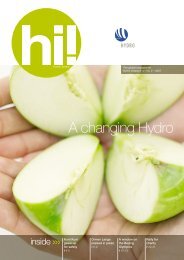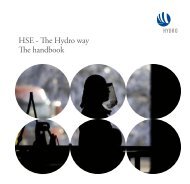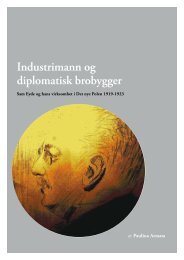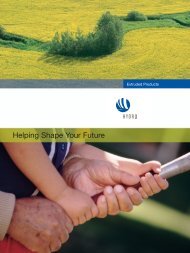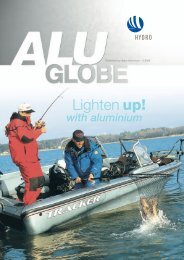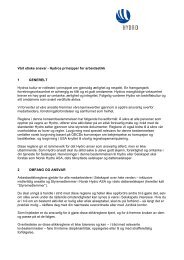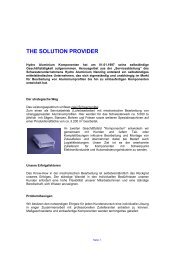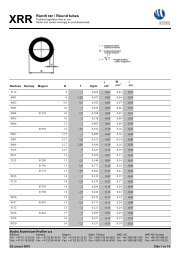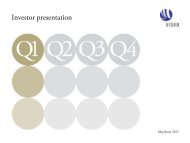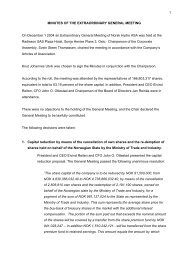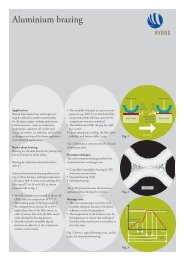Hydro Annual Report 2011b
Hydro Annual Report 2011b
Hydro Annual Report 2011b
Create successful ePaper yourself
Turn your PDF publications into a flip-book with our unique Google optimized e-Paper software.
for foundry alloys continued to be strong in Northern Europe<br />
and in Germany in particular, and also improved in Asia. <strong>Annual</strong>ized<br />
production of primary aluminium was relatively stable in<br />
the final quarter of 2011 amounting to 26.6 million mt globally<br />
(excluding China). Corresponding annualized consumption<br />
declined, however, to 24.7 million mt. Recent announcements<br />
of smelter closures and limited new capacity coming on stream<br />
are expected to improve the supply demand balance in 2012.<br />
Demand for primary aluminium is expected to grow by about<br />
3-5 percent in 2012. However, market sentiment continues to<br />
be influenced by significant economic uncertainty.<br />
European demand for downstream products was somewhat<br />
higher compared to 2010 as most markets continued to<br />
recover in the first half of 2011. However, demand weakened<br />
in the second half of 2011 due to increasing economic uncertainty<br />
in Europe and in Southern Europe in particular. Economic<br />
and market developments for 2012 are uncertain with<br />
low visibility. However, certain leading indicators are positive<br />
for rolled products. European demand for extruded aluminium<br />
products is expected to decline in 2012 with the building<br />
and construction market continuing to be the weakest end use<br />
market segment. Outside of Europe, the market outlook is<br />
positive, and within the automotive and transport segments in<br />
particular.<br />
Power production in Norway amounted to 127 TWh, which<br />
is 3 TWh higher than 2010. <strong>Hydro</strong>’s water reservoirs were well<br />
above normal at the end of 2011 and snow reservoirs increased<br />
significantly. As a result, production is expected to be high<br />
through the first quarter of 2012.<br />
Risk<br />
Risk management in <strong>Hydro</strong> is based on the principle that<br />
risk evaluation is an integral part of all business activities.<br />
Consequently, the business areas have the main responsibility<br />
for risk management, utilizing established policies and<br />
procedures. Their work is coordinated by staff units at the<br />
corporate level. The board of directors regularly reviews and<br />
evaluates the overall risk management system and environment<br />
within <strong>Hydro</strong>.<br />
<strong>Hydro</strong> faces risks and uncertainties within its worldwide<br />
business operations and in the global marketplace. The company<br />
is exposed to changing economic and market conditions<br />
and there has been a substantial increase in uncertainty<br />
regarding economic developments within the countries and<br />
geographic regions in which <strong>Hydro</strong> operates. The majority of<br />
<strong>Hydro</strong>’s primary aluminium plants are located in countries<br />
experiencing strong currencies and/or inflationary pressures,<br />
which weaken the competitive position of some of our operations.<br />
Compensating for future market declines is dependent<br />
on the company’s ability to sufficiently reduce our operating<br />
costs. The vale Aluminium acquisition represents a significant<br />
portion of <strong>Hydro</strong>’s capital employed and the company<br />
BoArD oF DIreCtors’ report<br />
Risk<br />
15<br />
may not realize the benefits expected. A deterioration of<br />
<strong>Hydro</strong>’s financial position or downgrade of the company’s<br />
credit rating could increase its borrowing cost and cost of<br />
capital. <strong>Hydro</strong> faces an ongoing risk of counterparty default.<br />
Price volatility can have a significant impact on <strong>Hydro</strong>’s<br />
reported results. <strong>Hydro</strong>’s reported and operating results and<br />
competitive position are influenced by developments in currency-exchange<br />
rates and in particular the U.S. dollar, Brazilian<br />
Real, Euro and Norwegian krone. <strong>Hydro</strong> is exposed to<br />
changing legislation on reducing CO 2 emissions. Major accidents,<br />
legal proceedings or investigations and incidents relating<br />
to HSE and corporate responsibility could impose<br />
significant costs and substantially damage the company’s<br />
reputation.<br />
<strong>Hydro</strong>’s main strategy for mitigating risk related to volatility<br />
in cash flows is to maintain a solid financial position and<br />
strong creditworthiness. In order to protect processing and<br />
manufacturing margins against raw material price fluctuations,<br />
<strong>Hydro</strong>’s downstream and other margin-based operations<br />
are hedged to a certain extent. <strong>Hydro</strong> also uses<br />
derivatives to reduce its overall financial and commercial risk<br />
exposures. forward U.S. dollar currency contracts have been<br />
used and <strong>Hydro</strong> has, to a limited extent, entered into forward<br />
contracts in other currencies to hedge certain revenue<br />
and cost positions. No major currency-forward contracts<br />
were outstanding at the end of 2011.<br />
Controls and procedures<br />
<strong>Hydro</strong> follows the Norwegian Code of Practice for Corporate<br />
Governance of October 2010. A detailed description of<br />
<strong>Hydro</strong>’s compliance with this code is presented on page 132.<br />
Information regarding the company’s shareholder policy can<br />
be found on page 115.<br />
The board’s audit committee carries out a control function and<br />
arranges for the board to deal with the company’s financial<br />
reporting.<br />
Research and development<br />
In 2011, research and development costs recognized as an<br />
expense amounted to NOK 508 million compared to NOK<br />
543 million in 2010.<br />
The greater part of our R&D expenses goes to our in-house<br />
research organization, while the remainder supports work carried<br />
out at external institutions. See Note 14. Our main R&D<br />
centers are in Årdal (primary aluminium technology) and<br />
Sunndal (alloys and casting) in Norway, Bonn in Germany<br />
(rolled products) and Toulouse in france (building systems).<br />
We reviewed our R&D organization in 2011. Starting in<br />
2012, all business areas will be responsible for their own technology<br />
development and execution of their respective technology<br />
strategies. As part of the new organizational model, a



